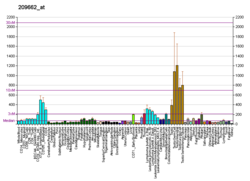Protein-coding gene in the species Homo sapiens
| CETN3 |
|---|
|
| Identifiers |
|---|
| Aliases | CETN3, CDC31, CEN3, centrin 3 |
|---|
| External IDs | OMIM: 602907 MGI: 1097706 HomoloGene: 74521 GeneCards: CETN3 |
|---|
| Gene location (Human) |
|---|
 | | Chr. | Chromosome 5 (human)[1] |
|---|
| | Band | 5q14.3 | Start | 90,392,257 bp[1] |
|---|
| End | 90,409,766 bp[1] |
|---|
|
| RNA expression pattern |
|---|
| Bgee | | Human | Mouse (ortholog) |
|---|
| Top expressed in | - oocyte
- secondary oocyte
- bronchial epithelial cell
- palpebral conjunctiva
- germinal epithelium
- Achilles tendon
- sperm
- amniotic fluid
- parietal pleura
- retinal pigment epithelium
|
| | | More reference expression data |
|
|---|
| BioGPS |  | | More reference expression data |
|
|---|
|
| Gene ontology |
|---|
| Molecular function | - calcium ion binding
- protein binding
- metal ion binding
- microtubule binding
| | Cellular component | - cytoplasm
- microtubule organizing center
- centriole
- centrosome
- nucleolus
- cytoskeleton
- nucleus
- nucleotide-excision repair factor 2 complex
- half bridge of spindle pole body
- transcription export complex 2
- nuclear pore nuclear basket
- nuclear envelope
- nuclear pore
| | Biological process | - cell cycle
- centrosome cycle
- cell division
- microtubule nucleation
- calcium-mediated signaling
- spindle pole body duplication
- mitotic spindle pole body duplication
- protein transport
- mRNA transport
| | Sources:Amigo / QuickGO |
|
| Orthologs |
|---|
| Species | Human | Mouse |
|---|
| Entrez | | |
|---|
| Ensembl | | |
|---|
| UniProt | | |
|---|
| RefSeq (mRNA) | |
|---|
NM_004365
NM_001297765
NM_001297768 |
| |
|---|
| RefSeq (protein) | |
|---|
NP_001284694
NP_001284697
NP_004356 |
| |
|---|
| Location (UCSC) | Chr 5: 90.39 – 90.41 Mb | n/a |
|---|
| PubMed search | [2] | [3] |
|---|
|
| Wikidata |
| View/Edit Human | View/Edit Mouse |
|
Centrin-3 is a protein that in humans is encoded by the CETN3 gene.[4][5] It belongs to the centrin family of proteins.
The protein encoded by this gene contains four EF-hand calcium binding domains, and is a member of the centrin protein family. Centrins are evolutionarily conserved proteins similar to the CDC31 protein of S. cerevisiae. Yeast CDC31 is located at the centrosome of interphase and mitotic cells, where it plays a fundamental role in centrosome duplication and separation. Multiple forms of the proteins similar to the yeast centrin have been identified in human and other mammalian cells, some of which have been shown to be associated with centrosome fractions. This protein appears to be one of the most abundant centrins associated with centrosome, which suggests a similar function to its yeast counterpart.[5]
References
- ^ a b c GRCh38: Ensembl release 89: ENSG00000153140 – Ensembl, May 2017
- ^ "Human PubMed Reference:". National Center for Biotechnology Information, U.S. National Library of Medicine.
- ^ "Mouse PubMed Reference:". National Center for Biotechnology Information, U.S. National Library of Medicine.
- ^ Middendorp S, Paoletti A, Schiebel E, Bornens M (Sep 1997). "Identification of a new mammalian centrin gene, more closely related to Saccharomyces cerevisiae CDC31 gene". Proc Natl Acad Sci U S A. 94 (17): 9141–6. Bibcode:1997PNAS...94.9141M. doi:10.1073/pnas.94.17.9141. PMC 23077. PMID 9256449.
- ^ a b "Entrez Gene: CETN3 centrin, EF-hand protein, 3 (CDC31 homolog, yeast)".
External links
Further reading
- Salisbury JL (2004). "Centrosomes: Sfi1p and centrin unravel a structural riddle". Curr. Biol. 14 (1): R27–9. Bibcode:2004CBio...14..R27S. doi:10.1016/j.cub.2003.12.019. PMID 14711432. S2CID 16717091.
- Wiech H, Geier BM, Paschke T, et al. (1996). "Characterization of green alga, yeast, and human centrins. Specific subdomain features determine functional diversity". J. Biol. Chem. 271 (37): 22453–61. doi:10.1074/jbc.271.37.22453. PMID 8798410.
- Paoletti A, Moudjou M, Paintrand M, et al. (1997). "Most of centrin in animal cells is not centrosome-associated and centrosomal centrin is confined to the distal lumen of centrioles". J. Cell Sci. 109 (13): 3089–102. doi:10.1242/jcs.109.13.3089. PMID 9004043.
- LeDizet M, Beck JC, Finkbeiner WE (1999). "Differential regulation of centrin genes during ciliogenesis in human tracheal epithelial cells". Am. J. Physiol. 275 (6 Pt 1): L1145–56. doi:10.1152/ajplung.1998.275.6.L1145. PMID 9843852.
- Laoukili J, Perret E, Middendorp S, et al. (2000). "Differential expression and cellular distribution of centrin isoforms during human ciliated cell differentiation in vitro". J. Cell Sci. 113 (8): 1355–64. doi:10.1242/jcs.113.8.1355. PMID 10725219.
- Lutz W, Lingle WL, McCormick D, et al. (2001). "Phosphorylation of centrin during the cell cycle and its role in centriole separation preceding centrosome duplication". J. Biol. Chem. 276 (23): 20774–80. doi:10.1074/jbc.M101324200. PMID 11279195.
- Strausberg RL, Feingold EA, Grouse LH, et al. (2003). "Generation and initial analysis of more than 15,000 full-length human and mouse cDNA sequences". Proc. Natl. Acad. Sci. U.S.A. 99 (26): 16899–903. Bibcode:2002PNAS...9916899M. doi:10.1073/pnas.242603899. PMC 139241. PMID 12477932.
- Schiebel E, Bornens M (2004). "In search of a function for centrins". Trends Cell Biol. 5 (5): 197–201. doi:10.1016/S0962-8924(00)88999-0. PMID 14731449.
- Gerhard DS, Wagner L, Feingold EA, et al. (2004). "The Status, Quality, and Expansion of the NIH Full-Length cDNA Project: The Mammalian Gene Collection (MGC)". Genome Res. 14 (10B): 2121–7. doi:10.1101/gr.2596504. PMC 528928. PMID 15489334.
- Cox JA, Tirone F, Durussel I, et al. (2005). "Calcium and magnesium binding to human centrin 3 and interaction with target peptides". Biochemistry. 44 (3): 840–50. doi:10.1021/bi048294e. PMID 15654740.
- Poole E, Strappe P, Mok HP, et al. (2005). "HIV-1 Gag-RNA interaction occurs at a perinuclear/centrosomal site; analysis by confocal microscopy and FRET". Traffic. 6 (9): 741–55. doi:10.1111/j.1600-0854.2005.00312.x. PMID 16101678. S2CID 36574274.
- Stelzl U, Worm U, Lalowski M, et al. (2005). "A human protein-protein interaction network: a resource for annotating the proteome". Cell. 122 (6): 957–68. doi:10.1016/j.cell.2005.08.029. hdl:11858/00-001M-0000-0010-8592-0. PMID 16169070. S2CID 8235923.














